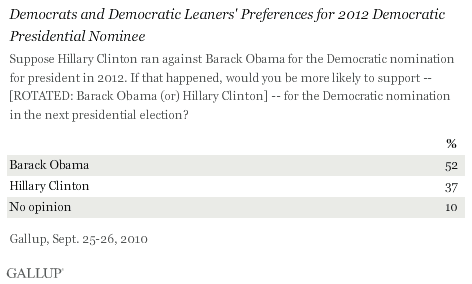PRINCETON, NJ -- If Secretary of State Hillary Clinton were to challenge President Barack Obama for the Democratic presidential nomination in 2012, she would currently have the support of 37% of Democrats nationally, while 52% would support Obama.

NBC's "Meet the Press" host David Gregory on Sept. 5 raised the possibility that Clinton might renew her battle against Obama for the Democratic Party's presidential nomination, asking outside White House adviser David Plouffe, "Do you envision a primary challenge from another Democrat in 2012 against this president?" Gregory then asked more specifically, "Do you -- can you rule out, based on actual information, that Secretary of State Clinton would not pursue the presidency again, would not challenge President Obama?"
Clinton was Obama's main challenger for the 2008 Democratic nomination in a long-fought and, at times, contentious battle. Once Obama clinched the nomination, Clinton and her husband Bill Clinton strongly supported Obama's nomination, and Hillary Clinton now serves in Obama's cabinet as secretary of state.
President Obama has yet to announce his intentions for 2012, although Harry Truman in 1952 and Lyndon Johnson in 1968 have been the only presidents since Calvin Coolidge to decline to seek re-election when they were eligible to do so.
Presidents with relatively low job approval ratings heading into a possible re-election bid are vulnerable to intra-party challenges. As two examples, Gerald Ford and Jimmy Carter were challenged for their respective parties' nomination as sitting presidents -- Ford by Ronald Reagan, and Carter by Edward Kennedy and Jerry Brown. Ford's job approval rating had reached as low as 37% in 1975, the year before he ran for re-election, and Carter's had reached 28% in 1979. Obama's current weekly job approval rating is 44%, albeit with more than two years until the next presidential election.
Obama's strengths among Democrats in the hypothetical matchup with Clinton lie with college graduates and liberals, the latter of whom make up about 36% of this sample of 859 Democrats and Democratic-leaning independents. Clinton does better among less well-educated Democrats and bests Obama among conservatives, who make up 22% of Democrats. Clinton does slightly better among women than among men.

Implications
As is the case for the 2012 Republican nomination, voter sentiments at this stage of the 2012 election cycle have low predictive validity. In late 2006, for example, Gallup polls showed that Clinton led Obama as the choice of Democrats for their party's nomination, and Rudy Giuliani was tied with John McCain for the Republican nomination (Giuliani pulled further ahead of McCain through most of 2007).
Even though most observers assume Obama will run for re-election, from time to time he has said he would be content to be a one-term president if he accomplished his goals. There is also the very real question of whether Clinton, or any other Democrat, will mount a challenge to Obama as 2012 approaches. That decision will in turn depend in part on Obama's perceived strengths and job approval ratings next year. These data show that conservative Democrats are the least likely to support Obama when Clinton is his hypothetical opponent, suggesting that Obama may be most vulnerable to a possible challenge from that wing of his party.
Results for this Gallup poll are based on telephone interviews conducted Sept. 25-26, 2010, on the Gallup Daily tracking survey, with a random sample of 859 Democrats and Democratic leaning independents, aged 18 and older, living in all 50 U.S. states and the District of Columbia, selected using random-digit-dial sampling.
For results based on the total sample of national adults, one can say with 95% confidence that the maximum margin of sampling error is ±4 percentage points.
Interviews are conducted with respondents on landline telephones and cellular phones, with interviews conducted in Spanish for respondents who are primarily Spanish-speaking. Each daily sample of national adults includes a minimum quota of 150 cell phone respondents and 850 landline respondents, with additional minimum quotas among landline respondents for gender within region. Landline respondents are chosen at random within each household on the basis of which member had the most recent birthday.
Samples are weighted by gender, age, race, education, region, and phone lines. Demographic weighting targets are based on the March 2009 Current Population Survey figures for the aged 18 and older non-institutionalized population living in continental U.S. telephone households. All reported margins of sampling error include the computed design effects for weighting and sample design.
In addition to sampling error, question wording and practical difficulties in conducting surveys can introduce error or bias into the findings of public opinion polls.
View methodology, full question results, and trend data.
For more details on Gallup's polling methodology, visit www.gallup.com.
